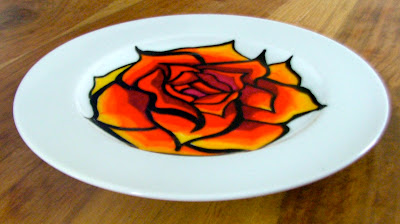10 years later, I am still fascinated by the art, culture and traditions of Mexico.
 |
| The Mexican Sunrise Plate. |
Floral, vivid patterns are also synonymous with Mexican art. Found on textiles, clothing and mosaics I have always found them pleasing to the eye. I wanted to create a floral design that was modern and again held some significance to me. I decided upon an English rose design, but painted in a traditional Mexican style, creating the Fiery English Rose plate. My family often referred to me as an 'English Rose' as a child and I am known for my passionate and somewhat fiery personality!
 |
| The Fiery English Rose Plate. |







